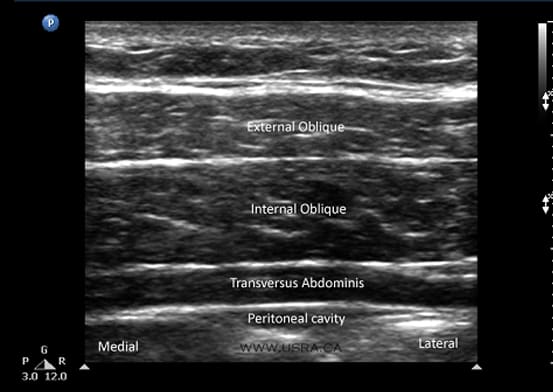Principle
The Transversus Abdominis Plane (TAP) Block is an injection of Local Anaesthetic into the anatomic plane between the internal oblique and the transversus abdominis muscle. First described by Rafi in 20011.
The thoracolumbar nerves (T6-L1) traverse this plane to supply sensory nerves to the anterolateral abdominal wall2. Local anaesthetic spread in this plane provides analgesia to the anterolateral abdominal wall.
Technique
Overview
For an in-depth review, this article is recommended3.
TAP blocks can be injected from a lateral, posterior or subcostal approach.
This can be done by direct visualisation intra-operatively (for example: DIEP or abdominoplasty cases) or by Ultrasound.

“Double-Pop”
After locating the triangle of Petit, the TAP is identified using the subjective double-pop loss of resistance technique. The first pop indicates penetration of the fascia of the external oblique muscle, and the second indicates piercing of the fascia of internal oblique and entry of the needle into the TAP4
Sources
- 1. Rafi A. Abdominal field block: a new approach via the lumbar triangle. Anaesthesia. 2001;56(10):1024-1026. https://www.ncbi.nlm.nih.gov/pubmed/11576144.
- 2. Rozen W, Tran T, Ashton M, Barrington M, Ivanusic J, Taylor G. Refining the course of the thoracolumbar nerves: a new understanding of the innervation of the anterior abdominal wall. Clin Anat. 2008;21(4):325-333. https://www.ncbi.nlm.nih.gov/pubmed/18428988.
- 3. Tsai H, Yoshida T, Chuang T, et al. Transversus Abdominis Plane Block: An Updated Review of Anatomy and Techniques. Biomed Res Int. 2017;2017:8284363. https://www.ncbi.nlm.nih.gov/pubmed/29226150.
- 4. McDonnell J, O’Donnell B, Farrell T, et al. Transversus abdominis plane block: a cadaveric and radiological evaluation. Reg Anesth Pain Med. 2007;32(5):399-404. https://www.ncbi.nlm.nih.gov/pubmed/17961838.


